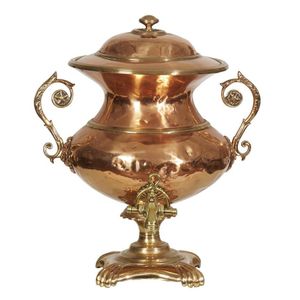Coalport Ewer and Jewelled Vase, circa 1910
You must be a subscriber, and be logged in to view price and dealer details.
Subscribe Now to view actual auction price for this item
When you subscribe, you have the option of setting the currency in which to display prices to $Au, $US, $NZ or Stg.
- Circa - A Latin term meaning 'about', often used in the antique trade to give an approximate date for the piece, usually considered to be five years on either side of the circa year. Thus, circa 1900 means the piece was made about 1900, probably between 1895 and 1905. The expression is sometimes abbreviated to c.1900.
- Manner of .... / Style of ..... - A cataloguing term where the item, in the opinion of the cataloguer is a work in the style of the artist, craftsman or designer, possibly of a later period.
- Ewer / Pitcher - A type of jug with a narrow neck bulbous body and wide spout, originally used for carrying and storing liquids such as water or wine. In medieval times they were the source of water to wash ones hands during and after a meal. later the shape was used for vessels in silver, gold, glass and ceramics.
In Victorian times they were made in ceramics and occasionally glass with a matching basin, and sometimes other accessories such as a soap holder or toothbrush holder. Their purpose was to provide facilities for personal washing In the early 19th century were often enclosed in purpose built stands, and later resided on a washstand..
Sometimes the words "ewer" and "pitcher" are used interchangably, but a pitcher is generally considered to be a jug, and would have a wide mouth, and a gently tapering body. - Gilding - Gilding is a method of ornamentation whereby a thin sheet of gold metal is applied to items made of wood, leather, ceramics, glass and silver for decorative purposes.
For furniture including mirrors, the sheet of gold is usually applied over a coating of gesso. Gesso is a mixture of plaster of Paris and gypsum mixed with water and then applied to the carved wooden frames of mirrors and picture frames as a base for applying the gold leaf. After numerous coats of gesso have been applied, allowed to dry and then sanded a coat of "bole", a usually red coloured mixture of clay and glue is brushed on and allowed to dry, after which the gold leaf is applied. Over time parts of the gilding will rub off so the base colour can be seen. In water gilding, this was generally a blue colour, while in oil gilding, the under layer was often yellow. In Victorian times, gilders frequently used red as a pigment beneath the gold leaf.
Metal was often gilded by a process known as fire gilding. Gold mixed with mercury was applied and heated, causing the mercury to evaporate, the long-term effect of which was to kill or disable the craftsman or woman from mercury poisoning. The pursuit of beauty has claimed many victims, not the least of which were the artists who made those pieces so highly sought after today. - Cartouche - An ornamental panel in the form of of a shield, oval or rectangular scroll with curling edges. It may be carved into the back of a chair or the top of a sideboard, or present on a piece of silver or jewellery, and contain the initials of the original owner, heraldic symbols, or some other inscription, such as the details of a presentation.
In ceramics the term defines the central area of a vase or similar with a decorative border in one of the shapes above, into which a decorative scene or figures have been painted. - Jewelled Decoration - Jewelled decoration on ceramics is a technique where small, colourful, and often metallic beads or "jewels" are applied to the surface of ceramic objects to create intricate and highly decorative designs. This technique has been used throughout history and across different cultures, but it was particularly popular during the late 19th and early 20th centuries, especially in Europe.
The jewelled decoration is usually applied by hand, one bead at a time, onto a base glaze or enamel. The beads can be made of glass, porcelain, or even precious stones, and are often set in a metal setting, such as gold or silver. The end result is a highly decorative and often luxurious surface, which can add a lot of visual interest and value to the ceramic object.
Jewelled decoration was used on a wide range of ceramic objects, including vases, plates, bowls, and figurines. It was particularly popular in the Art Nouveau and Art Deco periods, where it was used to create highly stylized and ornate designs.
This item has been included into following indexes:
Visually similar items

A pair of Coalport porcelain vases and covers, by Frederick Chivers, circa 1910, each with gilded acorn finials and rams mask handles, the central cartouche painted with assemblage of fruit the other with orchids framed with tooled gilt borders, 26 cm high

English hallmarked sterling silver Victorian jug with allover floral etched detail. Birmingham, 1863, maker Henry Hyde Aston, height 12.5 cm, weight 179g

A pair of gilt metal and marble urns, French, circa 1900 45 cm high

A brass and copper samovar height 42 cm
